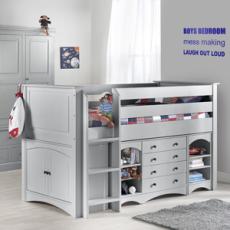
Children see the world differently to adults. Embrace this fact and work with your child to create a bedroom design that is infused with magic and imagination. According to a study by The Conversation, adults are limited in their design thinking by practical concerns of the everyday, but children are able to concentrate much more on experiencing and exploring space. Kids are the experts at being kids and are great at thinking of ideas if given the chance.
When decorating a child's bedroom you want it to be beautiful, superbly functional, and to be able to stand the test of time. By involving your child in the design process you will ensure an end result that not only ticks all of these boxes but is also perfectly tailored to their taste and personality. We hope that this article will inspire and help you to work with your child to design the perfect bedroom for them!
Establish Roles
As the authority figures in their lives, children are taught to listen to adults. When you are designing with your child you want to change this dynamic so that they feel like they can fully express themselves. Because when we are designing with someone we are creating for them, and not us. They are the real experts at knowing what would be useful for them, even if it is difficult for them to express it yet. So if your child has a crazy idea you should not detract from it by saying “that won’t work” or “that doesn’t make sense”. Rather ask your child “why” they want to do something and learn from their response. There is no magic formula for designing with children. You need to avoid being too authoritative but you also need to remain in control. As an adult your role is not just to get ideas from kids, it’s about working with them. Share your ideas too and listen to their responses.
Future & Current Wants & Needs
The current wants of your child for their bedroom are important but as a parent, it is also important to consider the practical aspects. This includes the bedroom’s current needs along with considering what will be needed in the future and how the bedroom can adapt to those future needs and wants. An example of this would be allowing your child to choose a beautiful children's bed, but only from options of beds that can adapt or will be suitable in the future as well. You want to aim to create a bedroom design that your child will love both now and for years to come. It is important to embrace your child’s current stage of life and interests so as to make a space they will thoroughly enjoy and engage them, but always keep the practical and the future in mind too.
Brainstorm Together
Work together with your child to bounce off ideas so that both of you are able to contribute to the final design. Letting your child know that they can express any idea is important. Discovering what emotions, values, ideas, dreams, and desires your child has around their current bedroom and their dream bedroom is a great way to establish what is important to them when it comes to their bedroom design. This is a crucial part of the design process. After the brainstorming session, you could work to synthesize the information by creating a final mood board. Depending on your child’s age, this could either be done alone or together. From this brainstorming, you will hopefully develop concepts for moving forward.
Choose Items Together
Get your child involved in the design process so that their personality truly shines through in their bedroom. When choosing items for your child's bedroom, there is a tendency for adults to favour of functionality. There is obviously a need for this but by getting your child involved in choosing decor and furniture pieces you will ensure that colourful and personalised details won’t be neglected. By allowing them to choose a few statement pieces and allowing them to add their own touches they will end up with a room they are truly proud of and happy to spend time in.
Children spend a lot of time in their bedroom sleeping, playing, and working. Therefore, it makes sense that their space should be a reflection of their personalities and be an engaging space for them. The best way to achieve this is to get them involved! We hope that this article will help you to navigate this task and create a happy and beautiful sanctuary for your child.
